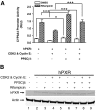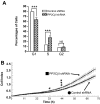Protein phosphatase 2Cbetal regulates human pregnane X receptor-mediated CYP3A4 gene expression in HepG2 liver carcinoma cells
- PMID: 20538721
- PMCID: PMC2939471
- DOI: 10.1124/dmd.110.032128
Protein phosphatase 2Cbetal regulates human pregnane X receptor-mediated CYP3A4 gene expression in HepG2 liver carcinoma cells
Abstract
The human pregnane X receptor (hPXR) regulates the expression of CYP3A4, which plays a vital role in hepatic drug metabolism and has considerably reduced expression levels in proliferating hepatocytes. We have recently shown that cyclin-dependent kinase 2 (CDK2) negatively regulates hPXR-mediated CYP3A4 gene expression. CDK2 can be dephosphorylated and inactivated by protein phosphatase type 2C beta isoform long (PP2Cbetal), a unique phosphatase that was originally cloned from human liver. In this study, we sought to determine whether PP2Cbetal is involved in regulating hPXR's transactivation activity and whether PP2Cbetal affects CDK2 regulation of this activity in HepG2 liver carcinoma cells. In transactivation assays, transiently coexpressed PP2Cbetal significantly enhanced the hPXR-mediated CYP3A4 promoter activity and decreased the inhibitory effect of CDK2 on hPXR transactivation activity. In addition, shRNA-mediated down-regulation of endogenous PP2Cbetal promoted cell proliferation, inhibited the interaction of hPXR with steroid receptor coactivator-1, and attenuated the hPXR transcriptional activity. The levels of PP2Cbetal did not affect hPXR expression. Our results show for the first time that PP2Cbetal is essential for hPXR activity and can positively regulate this activity by counteracting the inhibitory effect of CDK2. Our results implicate a novel and important role for PP2Cbetal in regulating hPXR activity and CYP3A4 expression by inhibiting or desensitizing signaling pathways that negatively regulate the function of pregnane X receptor in liver cells and are consistent with the notion that both the activity of hPXR and the expression of CYP3A4 are regulated in a cell cycle-dependent and cell proliferation-dependent manner.
Figures



Similar articles
-
Mg2+/Mn2+-dependent phosphatase 1A is involved in regulating pregnane X receptor-mediated cytochrome p450 3A4 gene expression.Drug Metab Dispos. 2015 Mar;43(3):385-91. doi: 10.1124/dmd.114.062083. Epub 2015 Jan 5. Drug Metab Dispos. 2015. PMID: 25561723 Free PMC article.
-
Cyclin-dependent kinase 2 negatively regulates human pregnane X receptor-mediated CYP3A4 gene expression in HepG2 liver carcinoma cells.J Biol Chem. 2008 Nov 7;283(45):30650-7. doi: 10.1074/jbc.M806132200. Epub 2008 Sep 9. J Biol Chem. 2008. PMID: 18784074 Free PMC article.
-
Correlation of PPM1A Downregulation with CYP3A4 Repression in the Tumor Liver Tissue of Hepatocellular Carcinoma Patients.Eur J Drug Metab Pharmacokinet. 2020 Apr;45(2):297-304. doi: 10.1007/s13318-019-00595-3. Eur J Drug Metab Pharmacokinet. 2020. PMID: 31792727
-
A phosphomimetic mutation at threonine-57 abolishes transactivation activity and alters nuclear localization pattern of human pregnane x receptor.Drug Metab Dispos. 2009 Apr;37(4):719-30. doi: 10.1124/dmd.108.024695. Epub 2009 Jan 26. Drug Metab Dispos. 2009. PMID: 19171678 Free PMC article.
-
Pregnane X receptor- and CYP3A4-humanized mouse models and their applications.Br J Pharmacol. 2011 Jun;163(3):461-8. doi: 10.1111/j.1476-5381.2010.01129.x. Br J Pharmacol. 2011. PMID: 21091656 Free PMC article. Review.
Cited by
-
Phosphorylation-Induced Ubiquitination and Degradation of PXR through CDK2-TRIM21 Axis.Cells. 2022 Jan 13;11(2):264. doi: 10.3390/cells11020264. Cells. 2022. PMID: 35053380 Free PMC article.
-
Diindolylmethane, a naturally occurring compound, induces CYP3A4 and MDR1 gene expression by activating human PXR.Toxicol Lett. 2015 Feb 3;232(3):580-9. doi: 10.1016/j.toxlet.2014.12.015. Epub 2014 Dec 24. Toxicol Lett. 2015. PMID: 25542144 Free PMC article.
-
Regulation of PXR and CAR by protein-protein interaction and signaling crosstalk.Expert Opin Drug Metab Toxicol. 2016 Sep;12(9):997-1010. doi: 10.1080/17425255.2016.1201069. Epub 2016 Jun 23. Expert Opin Drug Metab Toxicol. 2016. PMID: 27295009 Free PMC article. Review.
-
Thiazide-like diuretic drug metolazone activates human pregnane X receptor to induce cytochrome 3A4 and multidrug-resistance protein 1.Biochem Pharmacol. 2014 Nov 15;92(2):389-402. doi: 10.1016/j.bcp.2014.08.025. Epub 2014 Aug 30. Biochem Pharmacol. 2014. PMID: 25181459 Free PMC article.
-
IND-2, a pyrimido[1″,2″:1,5]pyrazolo[3,4-b]quinoline derivative, circumvents multi-drug resistance and causes apoptosis in colon cancer cells.Bioorg Med Chem. 2015 Feb 1;23(3):602-11. doi: 10.1016/j.bmc.2014.11.043. Epub 2014 Dec 8. Bioorg Med Chem. 2015. PMID: 25537531 Free PMC article.
References
-
- Bettoun DJ, Buck DW, 2nd, Lu J, Khalifa B, Chin WW, Nagpal S. (2002) A vitamin D receptor-Ser/Thr phosphatase-p70 S6 kinase complex and modulation of its enzymatic activities by the ligand. J Biol Chem 277:24847–24850 - PubMed
-
- Cheng A, Kaldis P, Solomon MJ. (2000) Dephosphorylation of human cyclin-dependent kinases by protein phosphatase type 2C alpha and beta 2 isoforms. J Biol Chem 275:34744–34749 - PubMed
-
- Ding X, Staudinger JL. (2005a) Induction of drug metabolism by forskolin: the role of the pregnane X receptor and the protein kinase a signal transduction pathway. J Pharmacol Exp Ther 312:849–856 - PubMed
-
- Ding X, Staudinger JL. (2005b) Repression of PXR-mediated induction of hepatic CYP3A gene expression by protein kinase C. Biochem Pharmacol 69:867–873 - PubMed
Publication types
MeSH terms
Substances
Grants and funding
LinkOut - more resources
Full Text Sources
Medical

